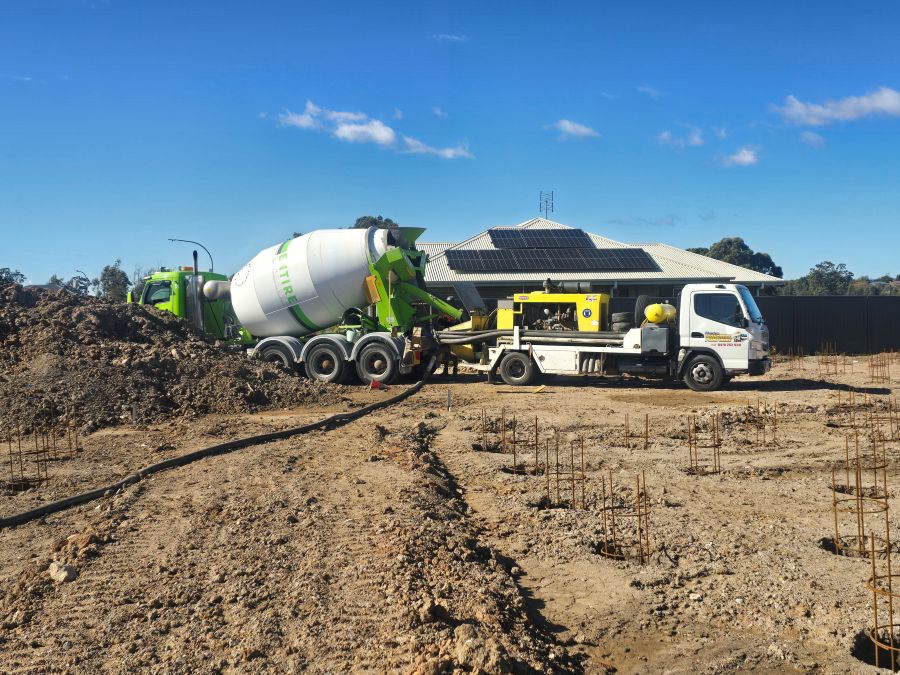Essential Best Practices for Ensuring Safe Concrete Pumping Operations in 2025
As we navigate the evolving landscape of concrete pumping safety in 2025, it is imperative to underscore the significance of comprehensive training, meticulous equipment inspections, clearly defined exclusion zones, and meticulous pre-start planning. Understanding the inherent risks linked with concrete pumping and adhering strictly to established safety protocols is vital for preventing accidents and ensuring that construction projects proceed on schedule. By prioritising these safety measures, workers can cultivate a secure working environment that not only enhances operational efficiency but also boosts productivity, ultimately setting the foundation for successful project completions.

Identifying and Addressing Common Hazards in Concrete Pumping Operations
According to SafeWork NSW, operators and personnel involved in concrete placement face considerable risks while setting up or operating concrete pumps. These hazards can manifest as:
- Unstable ground conditions or inadequate setups on sloped surfaces, potentially leading to catastrophic accidents.
- Utilising equipment beyond its design specifications, significantly increasing the risk of mechanical failures.
- Being in close proximity to overhead power lines, which poses severe electrocution risks.
- Collisions with trucks, structures, or site personnel, which can result in serious injuries.
- Hose whip and line surges, creating perilous situations if not effectively managed.
- Unforeseen equipment failures and blockages that could disrupt ongoing operations.
- Exposure to crush zones, diesel fumes, and excessive noise levels, which can negatively impact health.
- Slip, trip, and confined space hazards that may result in significant injuries.
These risks are not merely theoretical; they frequently materialise when safety procedures are either overlooked or inadequately enforced. Therefore, our unwavering commitment focuses on key safety elements on-site, ensuring that every worker is thoroughly informed and adheres to established protocols to foster a safer working environment.
1. Emphasise Comprehensive Training and Certification for All Team Members
Since concrete pumps operate under high pressure, stringent handling requirements for operators are essential. In NSW, it is crucial that operators possess:
- An HR licence for operating boom trucks, confirming their professional qualifications.
- Verified VOCs (Verification of Competency) to certify their skill levels.
- Training in hazard recognition and a thorough understanding of emergency stop procedures.
Moreover, hose handlers must receive comprehensive briefings to ensure they do not stand in discharge zones and can promptly identify blockages. This knowledge is crucial for maintaining operational safety and preventing accidents, ultimately protecting the entire crew.
2. Clearly Define Exclusion Zones to Enhance Safety Protocols
Concrete under pressure moves swiftly and can pose an extreme danger if released unexpectedly. Therefore, it is essential to have well-marked safety zones surrounding the hose and boom at all times. Essential safety measures should include:
- Utilising barriers and flagging to delineate risk areas around the pumping operation.
- Forbidding personnel from standing in front of the discharge area to mitigate injury risks.
- Restricting movements under booms to reduce the likelihood of accidents.
3. Conduct Thorough Equipment Inspections Prior to Each Pour
Each concrete pumping operation begins with a comprehensive equipment inspection. At Hunter Concrete Pumps, we carry out meticulous checks on:
- Hoses and reducers to confirm they are in optimal working condition.
- Couplings and clamps to ensure secure connections.
- The integrity of the boom and seals to prevent leaks.
- Primer levels, ensuring smooth and effective pump operation.
- Emergency shutoff systems to guarantee immediate response capabilities in the event of an incident.
No operation commences without the pump successfully passing all inspections, reinforcing our steadfast commitment to safety and operational efficiency.
4. Appoint a Lead Operator for Optimal Coordination and Communication
Effective communication is paramount to the success of concrete pumping operations. Each crew must designate one lead operator responsible for overseeing the pour and ensuring coordination with:
- Agitator drivers to synchronise operations for a seamless pouring process.
- Hose handlers who manage the flow of concrete safely and efficiently.
- Site supervisors to ensure strict adherence to site regulations.
- Concreters and finishers to achieve the desired project outcomes.
This clearly established chain of command is essential for preventing mistakes and misfires, ultimately enhancing both the safety and efficiency of the entire operation.
5. Initiate Every Pour with a Thorough Safety Briefing
Before commencing the pump operation, it is vital that the crew discusses several crucial topics, including:
- Site access and hose routing for optimal flow management.
- Emergency response plans and first aid protocols to ensure preparedness.
- Truck staging and washout procedures to maintain site cleanliness and orderliness.
- Identifying slip risks and ensuring that appropriate use of PPE (Personal Protective Equipment) is upheld for each crew member.
- Defining roles for spotters where necessary to further enhance safety measures.
At Hunter Concrete Pumps, we implement these protocols rigorously on every job, without exception, to ensure the safety of our crew and the integrity of the project.
The Indispensable Role of Safety in Concrete Pumping Operations
Ensuring safe concrete pours not only protects your crew but also safeguards your project timeline, budget, and reputation. A lapse in safety can lead to injuries, project delays, or regulatory scrutiny, risks that cannot be overlooked. We strictly comply with the SafeWork NSW guidelines for concrete pumping on every job. Our operators are not only trained but also licensed and insured, ensuring that when you choose our services, you are selecting a provider that integrates safety into every facet of the process.
Is It Necessary to Provide Spotters or Safety Personnel for My Concrete Pour?
For civil and commercial job sites, the answer is a resounding yes; spotters or safety personnel are critical for maintaining high safety standards. However, for residential projects, our dedicated pump crews are highly skilled at managing safety zones effectively, ensuring that the site remains secure. We will communicate any specific requirements during the quoting process to ensure clarity and compliance.
What Are the Most Common Safety Risks Associated with Concrete Pumping Jobs?
The three primary risks encompass untrained hose handling, inadequate access planning, and the absence of exclusion zones. We proactively mitigate all three of these critical issues before the concrete pour commences, ensuring a safer working environment for everyone involved in the operation.
Achieve Smooth and Safe Concrete Pours with Our Professional Expertise
Concrete pumping safety is not merely about adhering to excessive regulations; it focuses on ensuring the job is completed without injuries or delays. When your team is well-versed in safety procedures and your operator arrives fully equipped and prepared, the concrete pour can progress smoothly, swiftly, and without complications, paving the way for successful project outcomes.
Concrete Pump Hire
The Article: Concrete Pumping Safety Protocols: 2025’s Top 5 Tips first appeared on https://writebuff.com
The Article Concrete Pumping Safety Tips: Top 5 Protocols for 2025 Was Found On https://limitsofstrategy.com


It’s enlightening to see such a comprehensive outline of best practices for concrete pumping safety in 2025. Safety in construction is often an afterthought, but as you’ve pointed out, prioritizing comprehensive training and meticulous planning is essential for both worker well-being and project efficacy. I particularly appreciate your emphasis on clearly defined exclusion zones. It’s amazing how something as simple as proper communication and visible barriers can significantly decrease the risk of accidents on-site.
It’s great to hear your thoughts on the importance of safety in construction. You’re right; safety often takes a backseat until something goes wrong, which is unfortunate given how preventable most accidents can be with the right measures in place. I also find it fascinating how the industry is evolving with technology—like using drones for site surveillance or even augmented reality for training purposes. These advancements can enhance communication and help visualize exclusion zones more clearly.
I found this article really insightful—it dives into the critical aspects of concrete pumping safety, emphasizing training and clear communication, which are key for preventing accidents on-site.
‘Concrete Pumping: Essential Insights You Should Know’
https://berwickambassadors.co.uk/concrete-pumping-essential-insights-you-should-know/.
It’s encouraging to see others recognize the crucial role of safety in construction. The point you mentioned about technology reshaping our industry is spot on. Tools like drones and augmented reality are not just gimmicks; they’re game-changers. Drones can spot potential hazards from above, offering perspectives we might miss from the ground, while augmented reality can make training far more immersive and engaging.
You’ve hit the nail on the head about safety in construction—it’s like that last slice of pizza at a party; nobody thinks it’s valuable until it’s almost gone, or in this case, until something unexpected goes down. It really is crazy how preventable most accidents are; you’d think we’d be rolling out the red carpet for safety measures instead of making them the wallflower at the construction party.
I completely agree with you on the importance of making safety a priority in construction. It often takes a backseat, so raising awareness is crucial. Regarding exclusion zones, it’s fascinating to see how small adjustments can have such a big impact. Communication and visible barriers not only protect workers but also promote a culture of safety, making everyone more mindful on site.